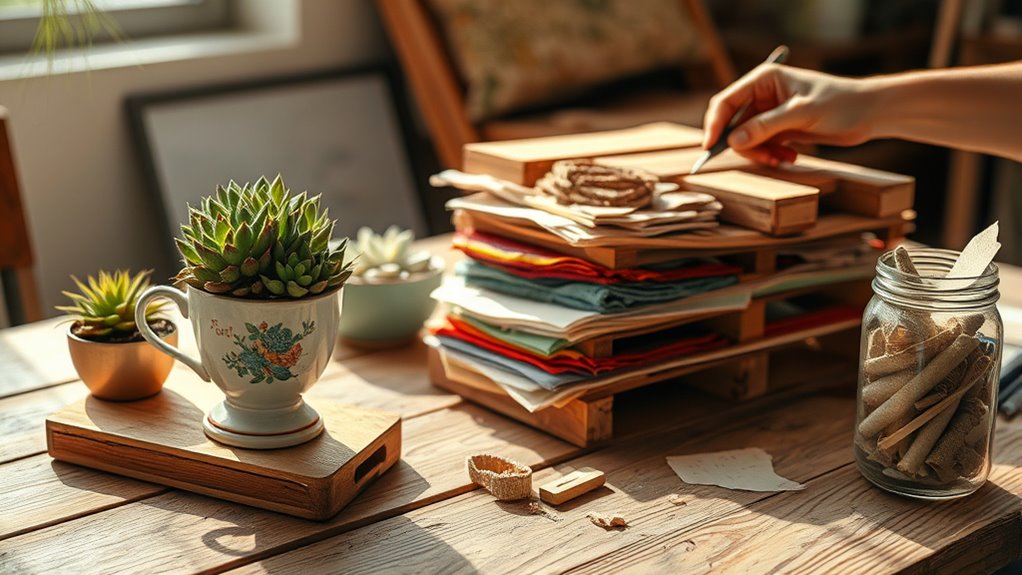By making small habits like repairing, repainting, or repurposing furniture a regular part of your routine, you can considerably reduce waste and support sustainability. Upcycling encourages creativity and resourcefulness, helping you live a greener life without extra expense. Simple actions, like choosing thrifted items or using reclaimed materials, add up to a big environmental impact over time. Keep exploring these habits, and you’ll discover even more ways to make a difference every day.
Key Takeaways
- Incorporate small repair and repurposing habits into daily routines to reduce waste and extend furniture lifespan.
- Use thrifted or reclaimed materials for DIY projects, promoting resourcefulness and sustainability.
- Choose eco-friendly paints and hardware to enhance the environmental benefits of upcycling efforts.
- Gradually increase DIY projects, building skills and impact over time while minimizing consumption.
- Seek inspiration and guidance from online tutorials and community resources to maintain motivation and innovation.

Many people are discovering that upcycling isn’t just a trend, but a sustainable way to live. It’s a mindset that encourages you to see potential in items others might discard. One of the most rewarding ways to embrace this lifestyle is through DIY furniture. Instead of buying new pieces, you can breathe new life into old furniture by sanding, painting, or repurposing it. Not only do you save money, but you also reduce waste that would otherwise end up in landfills. Creating your own furniture with upcycled materials allows you to customize pieces to fit your style while minimizing your environmental footprint. It’s a hands-on approach that combines creativity with practicality, giving you a sense of achievement every time you complete a project.
This practice aligns closely with the zero waste philosophy, which emphasizes reducing waste at every stage of consumption. When you prioritize DIY furniture and upcycling, you actively cut down on packaging waste, transportation emissions, and the demand for new raw materials. It’s about making smarter choices, like using leftover paint or reclaimed wood, to craft functional and attractive pieces. Small habits, such as repairing rather than replacing furniture or repurposing old items into storage solutions, markedly contribute to a zero waste lifestyle. Over time, these habits add up, creating a more sustainable home environment and reducing your ecological impact. Incorporating upcycling technologies like eco-friendly paints or sustainable hardware can further enhance the environmental benefits of your projects.
Getting started doesn’t have to be complicated. You might begin by browsing online tutorials or visiting thrift stores for inspiration. Look for sturdy furniture that just needs a facelift—perhaps a worn-out table that can be transformed with a fresh coat of paint or new hardware. You’ll find that many upcycling projects are simple and budget-friendly, making it easy to incorporate into your daily routine. As you gain confidence, you can experiment with more ambitious DIY furniture projects, like building a bookshelf from reclaimed pallets or turning an old door into a unique tabletop.
Frequently Asked Questions
How Can Beginners Start With Upcycling at Home?
You can start with simple DIY decor projects using items you already have, like jars or old furniture, to practice upcycling. Get creative with storage solutions, such as turning tin cans into organizers or wine bottles into vases. Follow online tutorials for ideas and techniques, and experiment in your free time. Small steps like these make upcycling approachable, fun, and eco-friendly, helping you integrate sustainable habits into your daily life.
What Are Eco-Friendly Materials Best for Upcycling Projects?
Think of eco-friendly materials as the seeds of change. You’ll find sustainable textiles like organic cotton and hemp perfect for upcycling, offering durability and a natural touch. Biodegradable plastics, made from cornstarch or plant-based sources, break down without harming the environment. Using these materials shows your commitment to renewal and growth, turning old items into meaningful creations that symbolize hope and a greener future.
How Does Upcycling Save Money Long-Term?
Upcycling saves you money long-term by reducing the need to buy new items and cutting waste disposal costs. You can implement cost-saving tips like repurposing furniture or clothing instead of purchasing new. Waste reduction strategies also help you save on materials and landfill fees. Over time, these habits lower your expenses, promote sustainability, and make your lifestyle more eco-friendly while giving old items a fresh new purpose.
Can Upcycling Be Incorporated Into a Busy Schedule?
Yes, you can incorporate upcycling into your busy schedule by dedicating short, focused sessions. For example, set aside 15-30 minutes weekly for creative storage ideas or furniture transformation projects. These small efforts add up over time and keep your space organized and stylish. You’ll find that with a little planning, upcycling becomes a manageable and rewarding part of your routine, making a big impact with minimal time investment.
What Are Common Mistakes to Avoid in Upcycling?
You can’t afford to ignore common upcycling mistakes, or you’ll turn your eco-friendly efforts into a disaster! Avoid rushing material selection or ignoring your sustainable mindset, which leads to poor results. Don’t overestimate your skills or underestimate the importance of proper preparation. Always plan your project, choose durable, appropriate materials, and stay committed to sustainability. Small mistakes can undo big environmental gains, so stay mindful and deliberate.
Conclusion
As you embrace upcycling, you’ll notice small habits turn into big changes—like a forgotten jar becoming a vibrant lantern or an old shirt transforming into a cozy tote. It’s funny how, in the midst of your cluttered closet, a spark of creativity can ignite a ripple of impact. Every tiny effort you make adds up, shaping a more sustainable world. Sometimes, the simplest act of upcycling is just the surprise your home—and the planet—needed.








